Dominion’s North Anna Station Sets New Standard for Earthquake Response
On August 23, 2011, at 1:51 p.m., a magnitude 5.8 earthquake knocked both units at Dominion’s North Anna Power Station off-line—the first time such an event has occurred in the U.S. After 80 days of extensive evaluation and inspection by plant staff and representatives from the U.S. Nuclear Regulatory Commission, both units were back online. What occurred during those days is a remarkable story.
Dominion is one of the nation’s largest producers and transporters of energy and routinely prepares for threats to service. But when the company’s North Anna Power Station experienced a magnitude 5.8 earthquake—the largest ever in Central Virginia—it became the first operating nuclear station in the U.S. to shut down because of a temblor and the first to experience an event that exceeded its design basis.
This event was also a first for the U.S. Nuclear Regulatory Commission (NRC), which would oversee remediation work after the event. Despite immense challenges, Dominion’s disciplined culture of safety, preparedness, operational excellence, and transparency successfully enabled it to work through the crisis on every level: engineering, public, and regulatory. As a result, the units returned to service in under three months (Figure 1).
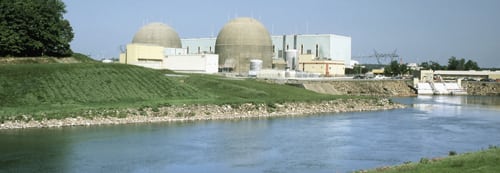
“Dominion’s culture is to be prepared for emergencies,” said David A. Christian, chief executive officer of Dominion Generation, the Dominion unit that operates North Anna. “We understood right away this would be a significant test. Our corporate values—safety, excellence, doing the right thing and teamwork—guided us in our response.” He added, “We wanted the operations, engineering, regulatory and public response to be the best we could possibly make it. We knew we had the right team and the know-how—and we knew that both Dominion’s reputation and the industry’s reputation were on the line.”
Record-Breaking Earthquake
North Anna Power Station’s 1,865-MW twin pressurized water reactors were at full power when the quake struck on August 23, 2011, at 1:51 p.m. The quake’s epicenter was 11 miles southwest of the station in Mineral, Va. Both of the station’s units shut down immediately, automatically, and safely. As a result of the earthquake, the plant lost off-site power from the switchyard, but back-up power from diesel generators picked up the load within 8 seconds, as designed. The station returned to off-site power later that evening.
The station declared an “Alert,” the next to lowest of the NRC’s four emergency classifications. Immediately, the company focused on ensuring that station workers and the public were safe. Then it began a thorough plant inspection process and proactively and transparently communicated with internal and external stakeholders that the reactors were in a safe and stable condition.
On the morning of August 24, North Anna downgraded from an Alert to a Notice of Unusual Event, the lowest of the four emergency classification levels, while the reactor cool-down and inspections of plant equipment and systems continued. The plant exited the Unusual Event that afternoon, after completing all walkdown inspections of the equipment that is most susceptible to seismic activity. Those inspections found that the equipment was in satisfactory condition.
Due to additional seismic activity, North Anna declared a second Unusual Event on August 25 following a reported magnitude 4.5 aftershock. The plant exited that Unusual Event later in the week. North Anna again declared an Unusual Event on the morning of September 1 for an aftershock, exiting the event shortly after noon that day. Over several weeks after the initial earthquake, the plant experienced a number of aftershocks, none resulting in any impact to plant structures, systems, or components.
This quake was felt from the South to the Midwest to New York City to Canada. It was felt at 13 locations with nuclear power plants, from North Carolina to Michigan (including Dominion’s other nuclear power station in Surry, Va., less than 100 miles from the North Anna location). Apart from North Anna, each of the affected stations notified the NRC of the unusual event and that they had not sustained any plant damage, interruption of service, or public safety issues.
Numerous buildings in the quake area sustained damage. Cracks even appeared in the Washington Monument in the nation’s capital, and the rumbling of the initial shock and aftershocks were felt throughout the Mid-Atlantic and Northeast U.S.
It is important to recall that the Central Virginia temblor occurred six months after the devastating earthquake and tsunami that crippled Japan’s Fukushima Daiichi nuclear station. The Japanese accident caused governments around the world to reevaluate their nuclear energy policies, and public interest in nuclear energy greatly intensified. This was new and unexplored territory for Dominion and the NRC. There was never any doubt that the company’s first priority was to ensure public safety. But Dominion also knew that in this time of extreme sensitivity to nuclear energy, the company’s response could very well set the tone for the future of nuclear energy policy.
Dominion soon realized the company would need to develop and obtain approval from the NRC for the appropriate process to restart the two units. (See the sidebar for a summary of the steps taken to restart the two units.) Dominion also knew that the NRC had little experience in dealing with a nuclear plant shutting down as a result of a beyond-design-basis earthquake. In fact, no nuclear unit in U.S. history had ever experienced a shutdown caused by a temblor.
Recovery and Restoration
Within 24 hours, the company’s North Anna Power Station restored off-site power and exited the emergency plan after completing all walkdown inspections of equipment most susceptible to seismic damage. This was in keeping with the company’s formal Corporate Emergency Response Plan, which includes an extensive public communications program. No damage was reported to systems required to maintain the station in a safe condition.
While the ground force accelerations from the earthquake did exceed North Anna’s licensed design basis for about 3 seconds, the station—built with multiple layers of safety—sustained no functional damage to safety systems, structures, or components. In fact, the extensive engineering analysis completed by the company demonstrated that it could have safely withstood a quake well above that experienced.
Using an NRC-endorsed document prepared by the Electric Power Research Institute (EPRI), the company assessed the overall impact on the station. On a scale from zero (where no functional damage is observed) to three (where very significant damage has occurred), the company’s detailed inspections determined that the earthquake ranked as zero impact for North Anna. However, to be extra thorough and safe, the company proceeded to evaluate the station as if the quake had an impact of one on the scale. This required far more extensive engineering inspections, testing, and analysis. That decision went a long way to establish up front that the company would be conservative and systematic. Dominion has since been lauded by nuclear safety experts as a prime example of an excellent nuclear safety culture.
Additionally, the company immediately brought in some of the top external seismic experts to walk down the station and put eyes on important adjacent structures to make sure the station was safe and that the company was not overlooking anything.
In the days and weeks that followed, a special NRC inspection team, with full cooperation from Dominion, thoroughly evaluated the company’s response to the earthquake, including initial actions by control room operators to place the unit in a safe and stable condition. They concluded that:
- Control room operators and station employees responded to the quake as trained.
- Safety systems engaged as designed and expected.
- No significant damage occurred to safety-related systems at the power station.
Additional inspections and analysis were performed by the NRC, and the company thoroughly documented its own inspections and analysis and responded to every question posed to it by NRC inspectors, engineers, and seismic experts. Before the NRC allowed the units to restart, the company had provided the NRC with more than 1,000 pages of documentation (Figure 2).
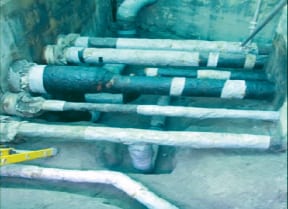

2. Rigorous inspections. Dominion visually inspected 100 feet of safety-related buried pipe with wall thickness verified by ultrasonic measurements. Courtesy: Dominion Generation
Examples of minor damage included nonstructural concrete cracking, insulation that was shaken off some pipes, and broken seals on electrical insulators attached to the main station transformers. These were repaired or replaced prior to restarting the units (Figures 3 and 4).

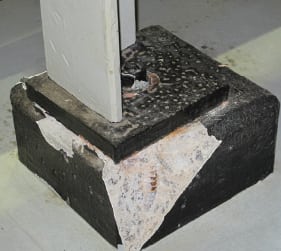
3. Minor repairs required. The minor damage experienced by the two stations cracked mortar and concrete. The necessary repairs were completed prior to restart. Courtesy: Dominion Generation
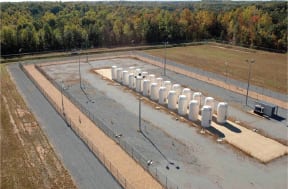
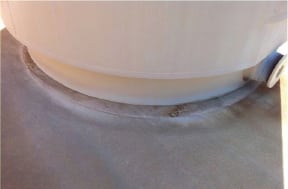
4. Short trip. The dry casks holding spent nuclear fuel moved from 1 to 4½ inches during the earthquake. Courtesy: Dominion Generation
As the reactors were returned to service, various measurements were taken each step of the way toward full-power operations to ensure that the equipment was operating as designed. Dominion developed a special Unit Restart Readiness Procedure—using information from other nuclear units that had been shut down by hurricanes, floods, and other external events—to control restart readiness and provide for system monitoring and plant performance oversight. These lessons were blended with Dominion’s already robust restart review and monitoring process. System Engineering and Operations physically observed and monitored the systems as they were placed in service, as well as the containment building, to make sure all components were working properly and as expected. At various phases, power escalation was stopped so additional testing could be performed to validate that equipment used to measure reactor power was all working precisely. All of this was documented.
Dominion placed its greatest emphasis on delivering the highest margin of safety and reliability as the North Anna units were returned to service. This process required significantly increased staffing, with representation from Engineering, Operations, Outage and Planning, Maintenance, and Management onsite 24 hours a day, seven days a week.
Dominion performed additional seismic analysis and update of licensing basis, added a “free-field” seismic instrument in a field, where its readings would be unaffected by any buildings, and added an uninterruptible power supply to one of the existing seismic detection systems to prevent power loss.
“When the quake struck, North Anna’s people responded as they were trained and the safety equipment operated as it was designed and built,” said David A. Heacock, president and chief nuclear officer of Dominion Virginia Power, a unit of Dominion. “They responded with every bit the same talent and dedication to inspect it afterwards, effect repairs and make it ready for safely resuming operation in what was really a very short amount of time under the circumstances.”
While the nuclear industry’s standard in evaluations of potential plant effects from an earthquake normally focuses on design basis ground motion response spectra—plotting measured accelerations (Figure 5) against shaking frequency—the latest and more sophisticated tool to gauge expected damage from an actual earthquake is called “cumulative absolute velocity” (CAV). CAV is the integrated absolute value of the acceleration time history for the earthquake. According to EPRI, CAV provides a better measure of the potential for damage to plant systems and structures for a specific earthquake than does a comparison of the experienced accelerations to the design response spectra.
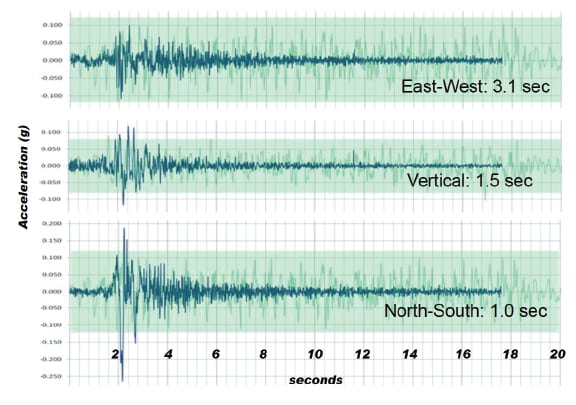
5. Three-second ride. The intensity of the earthquake was high but exceeded the plant’s design basis for only about 3 seconds. Source: Dominion Generation
CAV values for the August 23 earthquake indicated it was essentially at the level at which no significant damage had ever been observed for “engineered structures.” This is conservatively based on an analysis of damage to structures from hundreds of earthquakes around the world. It indicated that virtually no damage to safety-related systems and structures should be expected and that only very minimal damage should occur to other components. This was consistent with the findings of Dominion’s hundreds of inspections: no significant damage to seismically designed structures and systems or to conventionally designed structures.
The company and the NRC conducted thousands of inspections and exhaustive safety analyses, including of structural components, low-margin components, electrical systems, the Lake Anna Reservoir, the Waste Heat Treatment Facility, the North Anna Dam, the Independent Spent Fuel Storage Installation concrete pads and steel casks, and fuel and reactor vessel internal inspections. They specifically focused on potential hidden damage. Dominion completed:
- 134 system inspections.
- 141 structure inspections.
- More than 445 surveillance tests when the units were in a cold shutdown condition.
- More than 29 tests after the units were heated up to operating pressures and temperatures.
The overall effort to inspect and analyze the thousands of structures, systems, and components prior to returning the units to service required more than 110,000 person-hours and an expenditure of more than $21 million to fully ensure safety, repairs, and a station that was demonstrated to be ready for restart and continued safe operation.
Establishing a Protocol with the NRC
Before the August 23 quake, the NRC had spent two decades reviewing and evaluating U.S. Geological Survey earthquake hazard estimates for the central and eastern U.S. All operating nuclear units in the U.S. were built to withstand predicted maximum earthquake motion based on methods and techniques developed using data from the seismically active California region. This was because comparatively little was known at the time about the seismology of the eastern half of the U.S. The NRC had earlier reviewed seismic estimates for the central and eastern U.S. in a fact sheet issued by the agency in May 2011.
Over the past several years, a project jointly funded by the NRC, the Department of Energy, and EPRI developed new methodologies and data to determine the seismic hazard for this region. The NRC acknowledged in a post-Fukushima Daiichi accident fact sheet that “seismic hazard estimates at some current Central and Eastern U.S. operating sites may be potentially higher than what was expected during design and previous evaluations, although there is adequate protection at all plants.”
When the quake occurred, between the time that the earthquake hit Japan and the growing realization that the seismic hazard for some U.S. nuclear plants was greater than what they had been originally designed for, the stage was set for a potentially long and difficult review of North Anna’s readiness for restart. Dominion was able to demonstrate that the proposed startup plan would lead to safe and successful restoration of the station. In fact, the company went beyond established protocol to first convince itself that the station sustained no functional damage and could be restarted safely before presenting its finding to the NRC, which had to give permission for the units to return to service.
Dominion took the initiative to determine the process, communicate the details to the NRC and the public, systematically carry out the plan, and, finally, present the results in a clear, convincing manner. “The plant tells the story,” Heacock said. “We went over North Anna very systematically—every safety system, structure and component—and found no safety-related functional damage. Right from the beginning, we decided that we would not bring the station back up until both we and the NRC independently were fully satisfied as to its complete safety.”
Effective Crisis Management
In Dominion’s management of the restoration effort, safety was never compromised and electrical service to customers was never interrupted, even though the large generation station was out of service for nearly three months.
Dominion followed extensive safety verifications in restarting the units and worked very closely with the NRC and other organizations to involve them in the restart process and keep them informed step by step. Ongoing communications efforts included daily internal updates through conference calls as well as coverage in the company’s employee online Connect Today news service, in its newsmagazine Connect, and in internal briefings. Company representatives made presentations to civic organizations about the earthquake and activities undertaken to return the units to service.
The NRC conducted and Dominion participated in four public meetings—two in Louisa County and two at NRC headquarters in Rockville, Md. The company hosted North Anna tours for local and national news media to show them the station and the small amount of minor of damage incurred at the site and to counteract any criticism and misinformation by anti-nuclear organizations. Coverage was local, regional, national, and international, with company representatives issuing no fewer than four formal media announcements and participating in several hundred interviews.
Dominion was also proactive in communicating with state and local government officials. The day after the quake, the North Anna Power Station was visited by both Virginia Gov. Robert F. McDonnell and House Majority Leader Eric Cantor, whose Seventh Congressional District includes the site.
Dominion’s leadership moved the industry forward. The company worked with the NRC to establish the protocol for recovering from a nuclear station shutdown caused by an earthquake. The agency oversaw the process and approved the restart within three months of the quake. In contrast, repairs to the Washington Monument are scheduled to begin late this year and are expected to require 12 to 18 months to complete, even though a local philanthropist donated half the cost of repairs shortly after the quake.
Shaping the Nuclear Power Industry’s Present and Future
All in all, Dominion’s rapid and effective response to the record Central Virginia quake prevented an unreasonably extended outage. It also avoided lingering questions about nuclear safety and damage to the company’s and the industry’s reputations. The company went above and beyond regulatory requirements and in short, efficient order established the safety of its units and had them back online to produce low-cost, emissions-free power for its customers. In the process, it demonstrated that Dominion and the U.S. nuclear industry are capable of handling extreme, nature-induced emergencies in a safe, effective, and transparent manner—just as the public rightfully expects.
“Leadership in the nuclear industry can’t be just in science, engineering and technology,” said Christian. “A nuclear operating company has to be able to perform across the board, from safety and management to financial results, from complex regulatory issues to working effectively with a skeptical and sometimes hostile news media. I believe our results in this event demonstrated that we were up to the challenge.”
Clearly, the events of August 23 presented a challenge not only to Dominion but also to the entire nuclear power industry. Dominion’s commitment to safety first and the company’s leadership in establishing the standards for recovery from a crisis of this magnitude will positively affect the future of nuclear power generation in the U.S. and around the world.
—Dr. Robert Peltier, PE is POWER’s editor-in-chief. The substantial assistance provided by many Dominion employees in the preparation of this article is gratefully acknowledged.